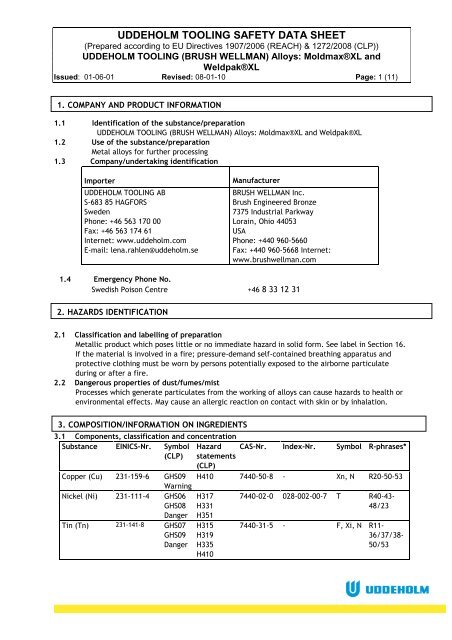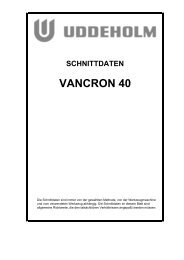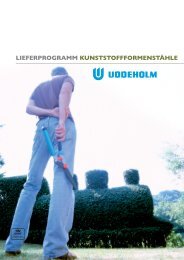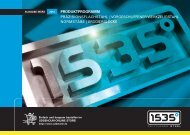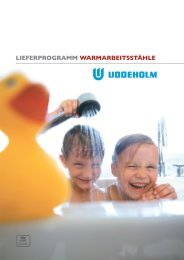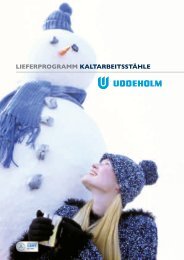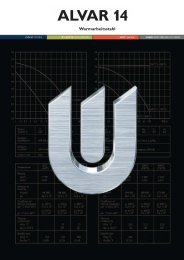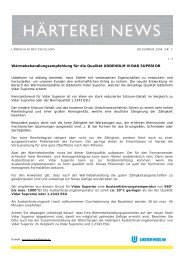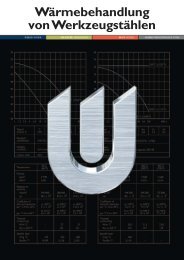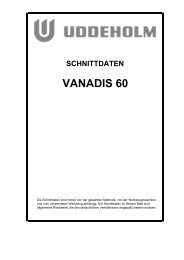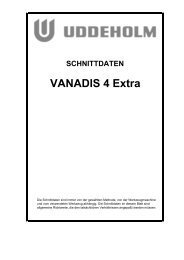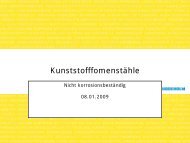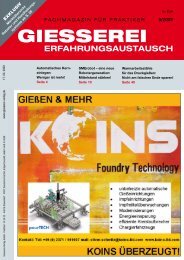Moldmax XL, Weldpak XL
Moldmax XL, Weldpak XL
Moldmax XL, Weldpak XL
You also want an ePaper? Increase the reach of your titles
YUMPU automatically turns print PDFs into web optimized ePapers that Google loves.
UDDEHOLM TOOLING SAFETY DATA SHEET<br />
(Prepared according to EU Directives 1907/2006 (REACH) & 1272/2008 (CLP))<br />
UDDEHOLM TOOLING (BRUSH WELLMAN) Alloys: <strong>Moldmax</strong>®<strong>XL</strong> and<br />
<strong>Weldpak</strong>®<strong>XL</strong><br />
Issued: 01-06-01 Revised: 08-01-10 Page: 1 (11)<br />
1. COMPANY AND PRODUCT INFORMATION<br />
1.1 Identification of the substance/preparation<br />
UDDEHOLM TOOLING (BRUSH WELLMAN) Alloys: <strong>Moldmax</strong>®<strong>XL</strong> and <strong>Weldpak</strong>®<strong>XL</strong><br />
1.2 Use of the substance/preparation<br />
Metal alloys for further processing<br />
1.3 Company/undertaking identification<br />
Importer<br />
UDDEHOLM TOOLING AB<br />
S-683 85 HAGFORS<br />
Sweden<br />
Phone: +46 563 170 00<br />
Fax: +46 563 174 61<br />
Internet: www.uddeholm.com<br />
E-mail: lena.rahlen@uddeholm.se<br />
Manufacturer<br />
BRUSH WELLMAN Inc.<br />
Brush Engineered Bronze<br />
7375 Industrial Parkway<br />
Lorain, Ohio 44053<br />
USA<br />
Phone: +440 960-5660<br />
Fax: +440 960-5668 Internet:<br />
www.brushwellman.com<br />
1.4 Emergency Phone No.<br />
Swedish Poison Centre +46 8 33 12 31<br />
2. HAZARDS IDENTIFICATION<br />
2.1 Classification and labelling of preparation<br />
Metallic product which poses little or no immediate hazard in solid form. See label in Section 16.<br />
If the material is involved in a fire; pressure-demand self-contained breathing apparatus and<br />
protective clothing must be worn by persons potentially exposed to the airborne particulate<br />
during or after a fire.<br />
2.2 Dangerous properties of dust/fumes/mist<br />
Processes which generate particulates from the working of alloys can cause hazards to health or<br />
environmental effects. May cause an allergic reaction on contact with skin or by inhalation.<br />
3. COMPOSITION/INFORMATION ON INGREDIENTS<br />
3.1 Components, classification and concentration<br />
Substance EINICS-Nr. Symbol Hazard CAS-Nr. Index-Nr. Symbol R-phrases*<br />
(CLP) statements<br />
(CLP)<br />
Copper (Cu) 231-159-6 GHS09<br />
Warning<br />
H410 7440-50-8 - Xn, N R20-50-53<br />
Nickel (Ni) 231-111-4 GHS06<br />
GHS08<br />
Danger<br />
Tin (Tn) 231-141-8 GHS07<br />
GHS09<br />
Danger<br />
H317<br />
H331<br />
H351<br />
H315<br />
H319<br />
H335<br />
H410<br />
7440-02-0 028-002-00-7 T R40-43-<br />
48/23<br />
7440-31-5 - F, Xi, N R11-<br />
36/37/38-<br />
50/53
UDDEHOLM TOOLING SAFETY DATA SHEET<br />
(Prepared according to EU Directives 1907/2006 (REACH) & 1272/2008 (CLP))<br />
UDDEHOLM TOOLING (BRUSH WELLMAN) Alloys: <strong>Moldmax</strong>®<strong>XL</strong> and<br />
<strong>Weldpak</strong>®<strong>XL</strong><br />
Issued: 01-06-01 Revised: 08-01-10 Page: 2 (11)<br />
Zinc (Zn) 231-175-3 GHS02<br />
GHS09<br />
Danger<br />
Warning<br />
Iron (Fe) 231-096-4 GHS02<br />
Danger<br />
H250<br />
H410<br />
7440-66-6 030-001-00-1 F, N R15-17-<br />
50/53<br />
H242 7439-89-6 - O R7<br />
*For complete wording of R-phrases and hazard statements see section 16.<br />
Substance (weight %) <strong>Moldmax</strong>®<strong>XL</strong> <strong>Weldpak</strong>®<strong>XL</strong><br />
Copper (Cu) 83 - 85 69 - 91<br />
Nickel (Ni) 8.5 - 9.5 6 - 18<br />
Tin (Tn) 5.5 - 6.5 3 - 12<br />
Zinc (Zn) 0 - 0.5 0 - 0.5<br />
Iron (Fe) 0 - 0.5 0 - 0.5<br />
4. FIRST-AID MEASURES<br />
4.1 General Information<br />
Show this safety data sheet to the doctor on duty.<br />
4.2 Inhalation<br />
If dust, fumes or mist inhaled, remove patient to fresh air, allow to rest and keep warm.<br />
Breathing difficulty caused by inhalation of particulate requires immediate removal to fresh air.<br />
If breathing has stopped, perform artificial respiration and obtain medical help.<br />
Copper: Inhalation of particulate containing metallic copper can cause ulceration and perforation<br />
of the nasal septum.<br />
4.3 Skin contact<br />
Thoroughly wash skin cuts or wounds to remove all particulate debris from the wound. Seek<br />
medical attention for wounds that cannot be thoroughly cleansed. Treat skin cuts and wounds<br />
with standard first aid practices such as cleansing, disinfecting and covering to prevent wound<br />
infection and contamination before continuing work. Obtain medical help for persistent<br />
irritation. Material accidentally implanted or lodged under the skin must be removed.<br />
Copper: Particulate may cause a greenish-black skin discoloration.<br />
4.4 Eye contact<br />
Avoid getting finely divided particles in the eyes. Immediately flush eyes with plenty of water for<br />
at least 15 minutes, lifting lower and upper eyelids occasionally. Get medical attention<br />
immediately.<br />
Copper: Particulate in the eyes may cause discoloration.<br />
4.5 Ingestion<br />
Alloys in massive form are not hazardous, but should be kept out of the mouth. Finely divided<br />
particles may be easily ingested along with food, drink or smoking. If large quantities ingested,<br />
seek medical advice. Induce vomiting immediately as directed by medical personnel. Never give<br />
anything by mouth to an unconscious person.
UDDEHOLM TOOLING SAFETY DATA SHEET<br />
(Prepared according to EU Directives 1907/2006 (REACH) & 1272/2008 (CLP))<br />
UDDEHOLM TOOLING (BRUSH WELLMAN) Alloys: <strong>Moldmax</strong>®<strong>XL</strong> and<br />
<strong>Weldpak</strong>®<strong>XL</strong><br />
Issued: 01-06-01 Revised: 08-01-10 Page: 3 (11)<br />
5. FIRE-FIGHTING MEASURES<br />
Flash Point<br />
Explosive Limits<br />
Extinguishing Media<br />
Unusual Fire and<br />
Explosion Hazards<br />
Special Fire Fighting<br />
Procedures<br />
Non-combustible as a solid. No ignition as layer of sub 44 micron particles of<br />
copper.<br />
Not applicable to solids. No ignition as cloud of sub 44 micron particles of<br />
nominal copper.<br />
This material is non-combustible. Use extinguishing media appropriate to the<br />
surrounding fire.<br />
Do not use water to extinguish fires around operations involving molten metal<br />
due to the potential for steam explosions.<br />
Pressure-demand self-contained breathing apparatus must be worn by<br />
firefighters or any other persons potentially exposed to the metal fumes or<br />
dust released during or after a fire.<br />
6. ACCIDENTAL RELEASE MEASURES<br />
If this material is a particulate, establish a restricted entry zone based on the severity of the<br />
spill. Persons entering the restricted zone must wear adequate respiratory protection and<br />
protective clothing appropriate for the severity of the spill (see Section 8). Cleanup spills with a<br />
vacuum system utilizing a high efficiency particulate air (HEPA) filtration system followed by wet<br />
cleaning methods. Special precautions must be taken when changing filters on HEPA vacuum<br />
cleaners used to clean up hazardous materials. Be careful to minimize airborne generation of<br />
particulate and avoid contamination of air and water.<br />
7. HANDLING AND STORAGE<br />
7.1 Recommendations for safe handling<br />
No special precautions necessary for alloys in massive form other than normal physical handling<br />
techniques. Extraction should be used when working with particulate material (dust, fumes,<br />
mist). Avoid prolonged inhalation of dust. Wear gloves to avoid contact with skin (see Section 8).<br />
7.2 Storage<br />
Store in a dry area.<br />
8. EXPOSURE CONTROLS/PERSONAL PROTECTION<br />
8.1 Constituents<br />
CONSTITUENTS OSHA* ACGIH* NIOSH RTECS<br />
NUMBER<br />
PEL CEILING PEAK TLV TLV-STEL<br />
Copper Dust & Mist 1 N/A N/A 1 N/A GL5325000<br />
Copper Fume 0.1 N/A N/A 0.2 N/A GL5325000<br />
Iron Oxide Fume 10 N/A N/A N/A N/A NO456550<br />
Iron Oxide<br />
N/A N/A N/A 5 N/A NO7400000<br />
Respirable<br />
Nickel 1 N/A N/A 1.5 N/A QR5950000<br />
Tin 2 N/A N/A 2 N/A XP7320000
UDDEHOLM TOOLING SAFETY DATA SHEET<br />
(Prepared according to EU Directives 1907/2006 (REACH) & 1272/2008 (CLP))<br />
UDDEHOLM TOOLING (BRUSH WELLMAN) Alloys: <strong>Moldmax</strong>®<strong>XL</strong> and<br />
<strong>Weldpak</strong>®<strong>XL</strong><br />
Issued: 01-06-01 Revised: 08-01-10 Page: 4 (11)<br />
Zinc Oxide Fume 5 N/A N/A N/A N/A ZH4810000<br />
Zinc Oxide<br />
5 N/A N/A 2 N/A ZH4810000<br />
Respirable<br />
Zinc Oxide<br />
Total Dust<br />
15 N/A N/A N/A N/A ZH4810000<br />
*ALL CONCENTRATIONS ARE IN MILLIGRAMS PER CUBIC METER OF AIR<br />
(at the concentrations noted above, these constituents may not be visible to the human eye)<br />
A leading scientific body recommending occupational standards is the American Conference of Governmental Industrial<br />
Hygienists (ACGIH). The ACGIH recommends standards for all listed substances. The ACGIH defines a threshold limit<br />
value (standard) as follows: “Threshold Limit Values refer to airborne concentrations of substances and represent<br />
conditions under which it is believed that nearly all workers may be repeatedly exposed day after day without adverse<br />
health effects. Because of wide variation in individual susceptibility, however, a small percentage of workers may<br />
experience discomfort from some substances at concentrations at or below the threshold limit; a smaller percentage<br />
may be affected more seriously by aggravation of a pre-existing condition or by development of an occupational illness.”<br />
“Individuals may also be hypersusceptible or otherwise unusually responsive to some industrial chemicals because of<br />
genetic factors, age, personal habits (smoking, alcohol, or other drugs), medication, or previous exposures. Such<br />
workers may not be adequately protected from adverse health effects from certain chemicals at concentrations at or<br />
below the threshold limits.”<br />
ACGIH = American Conference of Governmental Industrial Hygienists<br />
OSHA = Occupational Safety and Health Administration<br />
PEL = Eight-Hour Average Permissible Exposure Limit (OSHA)<br />
CEILING = Not To Be Exceeded Except for Peak Limit (OSHA)<br />
PEAK = 30-Minute Maximum Duration Concentration Above Ceiling Limit (OSHA)<br />
TLV = Eight-Hour Average Threshold Limit Value (ACGIH)<br />
TLV-STEL = 15-Minute Short Term Exposure Limit (ACGIH)<br />
CAS = Chemical Abstract Service<br />
NIOSH = National Institute for Occupational Safety and Health<br />
RTECS = Registry of Toxic Effects of Chemical Substances<br />
The manufacture recommends following good industrial hygiene practice which includes reducing<br />
airborne exposures to the lowest feasible level for all constituents in this product.<br />
8.2 Control of Exposure<br />
8.2.1 Respiratory protection<br />
Extraction should be used when working with particulate material (dust, fumes, mist). In case of<br />
prolonged or frequent exposure to particulates, wear particle filter mask. When airborne<br />
exposures exceed or have the potential to exceed the occupational limits shown in Section 8.1,<br />
approved respirators must be used as specified by an Industrial Hygienist or other qualified<br />
professional. Respirator users must be medically evaluated to determine if they are physically<br />
capable of wearing a respirator. Quantitative and/or qualitative fit testing and respirator training<br />
must be satisfactorily completed by all personnel prior to respirator use. Users of tight fitting<br />
respirators must be clean shaven on those areas of the face where the respirator seal contacts<br />
the face. Exposure to unknown concentrations of particulate requires the wearing of a pressuredemand<br />
airline respirator or pressure-demand self-contained breathing apparatus (SCBA). Use<br />
pressure-demand airline respirators when performing jobs with high potential exposures such as<br />
changing filters in a baghouse air cleaning device.<br />
8.2.2 Skin protection<br />
Wear hand protection, eg leather gloves when handling alloys with sharp edges to avoid cuts.<br />
Always wear disposable nitrile or vinyl gloves when handling particulate material to avoid skin<br />
contact. Where necessary wear the disposable gloves under work gloves to protect against both<br />
types of hazard.
UDDEHOLM TOOLING SAFETY DATA SHEET<br />
(Prepared according to EU Directives 1907/2006 (REACH) & 1272/2008 (CLP))<br />
UDDEHOLM TOOLING (BRUSH WELLMAN) Alloys: <strong>Moldmax</strong>®<strong>XL</strong> and<br />
<strong>Weldpak</strong>®<strong>XL</strong><br />
Issued: 01-06-01 Revised: 08-01-10 Page: 5 (11)<br />
8.2.3 Eye protection<br />
Always wear eye protection when handling dusts and other particulates, eg safety glasses with<br />
side protection, safety goggles or visor.<br />
Wear safety glasses, goggles, face shield, or welder’s helmet when risk of eye injury is present,<br />
particularly during melting, casting, machining, grinding, welding, powder handling, etc.<br />
8.2.4 Protective clothing<br />
Always wear protective clothing when handling dusts and other particulates.<br />
Wear gloves to prevent contact with particulate or solutions. Wear gloves to prevent metal cuts<br />
and skin abrasions during handling.<br />
8.2.5 Other protective equipment<br />
Protective overgarments or work clothing must be worn by persons who may become<br />
contaminated with particulate during activities such as machining, furnace rebuilding, air<br />
cleaning equipment filter changes, maintenance, furnace tending, etc. Contaminated work<br />
clothing and overgarments must be managed in a controlled manner to prevent secondary<br />
exposure to workers of third parties, to prevent the spread of particulate to other areas, and to<br />
prevent particulate from being taken home by workers.<br />
8.2.6 General hygiene measures<br />
Wash hands well with soap and water after handling dusty materials. Wash contaminated<br />
clothing to avoid secondary contamination or contamination of other personnel.<br />
8.3 Technical advice.<br />
8.3.1 Ventilation and engineering controls<br />
Whenever possible, the use of local exhaust ventilation or other engineering controls is the<br />
preferred method of controlling exposure to airborne particulate. Where utilized, exhaust inlets<br />
to the ventilation system must be positioned as close as possible to the source of airborne<br />
generation. Avoid disruption of the airflow in the area of a local exhaust inlet by equipment such<br />
as a man-cooling fan. Check ventilation equipment regularly to ensure it is functioning properly.<br />
Provide training on the use and operation of ventilation to all users. Use qualified professionals<br />
to design and install ventilation systems.<br />
8.3.2 Work practises<br />
Develop work practices and procedures that prevent particulate from coming in contact with<br />
worker skin, hair, or personal clothing. If work practices and/or procedures are ineffective in<br />
controlling airborne exposure or visual particulate from deposition on skin, hair, or clothing,<br />
provide appropriate cleaning/washing facilities. Procedures should be written that clearly<br />
communicate the facility’s requirements for protective clothing and personal hygiene. These<br />
clothing and personal hygiene requirements help keep particulate from being spread to nonproduction<br />
areas or from being taken home by the worker. Never use compressed air to clean<br />
work clothing or other surfaces.<br />
Fabrication processes may leave a residue of particulate on the surface of parts, products or<br />
equipment that could result in employee exposure during subsequent material handling activities.<br />
As necessary, clean loose particulate from parts between processing steps. As a standard hygiene<br />
practice, wash hands before eating or smoking.<br />
To prevent exposure, remove surface scale or oxidation formed on cast or heat treated products<br />
in an adequately ventilated process prior to working the surface<br />
8.3.3 Wet methods<br />
Machining operations are usually performed under a liquid lubricant/coolant flood which assists<br />
in reducing airborne particulate. However, the cycling through of machine coolant containing<br />
finely divided particulate in suspension can result in the concentration building to a point where<br />
the particulate may become airborne during use. Certain processes such as sanding and grinding<br />
may require complete hooded containment and local exhaust ventilation. Prevent coolant from
UDDEHOLM TOOLING SAFETY DATA SHEET<br />
(Prepared according to EU Directives 1907/2006 (REACH) & 1272/2008 (CLP))<br />
UDDEHOLM TOOLING (BRUSH WELLMAN) Alloys: <strong>Moldmax</strong>®<strong>XL</strong> and<br />
<strong>Weldpak</strong>®<strong>XL</strong><br />
Issued: 01-06-01 Revised: 08-01-10 Page: 6 (11)<br />
splashing onto floor areas, external structures or operators’ clothing. Utilize a coolant filtering<br />
system to remove particulate from the coolant.<br />
8.3.4 Respiratory protection<br />
When airborne exposures exceed or have the potential to exceed the occupational limits shown<br />
in Section 8.12, approved respirators must be used as specified by an Industrial Hygienist or other<br />
qualified professional. Respirator users must be medically evaluated to determine if they are<br />
physically capable of wearing a respirator. Quantitative and/or qualitative fit testing and<br />
respirator training must be satisfactorily completed by all personnel prior to respirator use. Users<br />
of tight fitting respirators must be clean shaven on those areas of the face where the respirator<br />
seal contacts the face. Exposure to unknown concentrations of particulate requires the wearing<br />
of a pressure-demand airline respirator or pressure-demand self-contained breathing apparatus<br />
(SCBA). Use pressure-demand airline respirators when performing jobs with high potential<br />
exposures such as changing filters in a baghouse air cleaning device.<br />
8.4 Housekeeping & maintenance<br />
Use vacuum and wet cleaning methods for particulate removal from surfaces. Be certain to deenergize<br />
electrical systems, as necessary, before beginning wet cleaning. Use vacuum cleaners<br />
with high efficiency particulate air (HEPA). Do not use compressed air, brooms, or conventional<br />
vacuum cleaners to remove particulate from surfaces as this activity can result in elevated<br />
exposures to airborne particulate. Follow the manufacturer’s instructions when performing<br />
maintenance on HEPA filtered vacuums used to clean hazardous materials.<br />
During repair or maintenance activities the potential exists for exposures to particulate in excess<br />
of the occupational standards. Under these circumstances, protecting workers can require the<br />
use of specific work practices or procedures involving the combined use of ventilation, wet and<br />
vacuum cleaning methods, respiratory protection, decontamination, special protective clothing,<br />
and when necessary, restricted work zones.<br />
8.5 Welding<br />
Local exhaust or general ventilating systems must be provided and arranged to keep the amount<br />
of toxic fumes, gases, or dusts below the maximum allowable concentration for the constituents<br />
listed in Section 3.<br />
8.6 Exposure Characterization<br />
Determine exposure to airborne particulate by air sampling in the employee breathing zone, work<br />
area, and department. Utilize an Industrial Hygienist or other qualified professional to specify<br />
the frequency and type of air sampling. Develop and utilize a sampling strategy which identifies<br />
the extent of exposure variation and provides statistical confidence in the results. Conduct an<br />
exposure risk assessment of processes to determine if conditions or situations exist which dictate<br />
the need for additional controls or improved work practices. Make air sample results available to<br />
employees.<br />
9. PHYSICAL AND CHEMICAL PROPERTIES<br />
PHYSICAL PROPERTIES<br />
Product names Color Melting point Density<br />
<strong>Moldmax</strong>®<strong>XL</strong> Bronze 1697°F 0.321lb/in 3<br />
<strong>Weldpak</strong>®<strong>XL</strong> Bronze 1742°F 0.323lb/in 3
UDDEHOLM TOOLING SAFETY DATA SHEET<br />
(Prepared according to EU Directives 1907/2006 (REACH) & 1272/2008 (CLP))<br />
UDDEHOLM TOOLING (BRUSH WELLMAN) Alloys: <strong>Moldmax</strong>®<strong>XL</strong> and<br />
<strong>Weldpak</strong>®<strong>XL</strong><br />
Issued: 01-06-01 Revised: 08-01-10 Page: 7 (11)<br />
10. STABILITY AND REACTIVITY<br />
10.1 Stability<br />
Alloys are stable. Corrosion should not take place under normal circumstances. Hazardous<br />
decomposition products: none under normal conditions of use. Hazardous Polymerization will not<br />
occur.<br />
10.2 Materials to avoid<br />
Reacts with some acids and caustic solutions to produce hydrogen gas. Hydrogen gas can be an<br />
explosion hazard. Powdered aluminum and chlorinated hydrocarbons may react with explosive<br />
violence.<br />
11. TOXICOLOGICAL INFORMATION<br />
11.1 Effect on humans<br />
Alloys contain nickel which carries a risk of producing an allergic reaction following prolonged contact<br />
or in already sensitised persons. Particles from the alloy are not judged as acute toxic.<br />
11.2 Acute toxicity<br />
No LC50 or LD50 has been established for the mixture as a whole.<br />
Iron - Oral LD 50 rat 30000mg/kg bodyweight (not harmful)<br />
Nickel: Oral LD 50 rat<br />
1500 mg/kg bodyweight<br />
11.3 Further information<br />
For questions concerning toxicological information, write to: Medical Director, Brush Wellman<br />
Inc., 14710 West Portage River South Road, Elmore, Ohio 43416-9502.<br />
12. ECOLOGICAL INFORMATION<br />
12.1 Mobility<br />
Metal alloys are not soluble in water. Particles formed by working alloys can be transported in<br />
the air.<br />
12.2 Bioaccumulation<br />
Alloys contain heavy metals which can probably bioaccumulate in the food chain.<br />
12.3 Ecotoxicity<br />
Alloys contain metals which are considered to be very toxic towards aquatic organisms. Finely<br />
divided alloys are therefore considered harmful to aquatic organisms.<br />
12.4 Further information<br />
In massive form alloys present no hazards to the aquatic environment. Particles and ions can,<br />
never the less, enter the aquatic compartment by means of dusts or smoke, or by liberation due<br />
to erosion thereby introducing iron or heavy metals into the ground or water.<br />
This material can be recycled; contact your Sales Representative.<br />
13. DISPOSAL CONSIDERATIONS<br />
The unused product (massive alloy) is not classified as hazardous waste. Dispose in accordance<br />
with appropriate government regulations. When recycled (used in a process to recover metals),<br />
this material is not classified as hazardous waste under federal law. Seal particulate or<br />
particulate containing materials inside two plastic bags, place in a DOT approved container, and<br />
label appropriately.
UDDEHOLM TOOLING SAFETY DATA SHEET<br />
(Prepared according to EU Directives 1907/2006 (REACH) & 1272/2008 (CLP))<br />
UDDEHOLM TOOLING (BRUSH WELLMAN) Alloys: <strong>Moldmax</strong>®<strong>XL</strong> and<br />
<strong>Weldpak</strong>®<strong>XL</strong><br />
Issued: 01-06-01 Revised: 08-01-10 Page: 8 (11)<br />
When spent products are declared solid wastes (no longer recyclable) and any residues of finely divided<br />
product (particles, dust, fumes) are regarded as Hazardous Waste and must be labeled, managed and<br />
disposed of, in accordance with federal, state and local requirements. Contact your local entrepreneur<br />
for advice.<br />
14. TRANSPORT INFORMATION<br />
There are no U.S. Department of Transportation hazardous material regulations which apply to<br />
the packaging and labeling of this product as shipped by Brush Wellman.<br />
Hazard Communication regulations of the U.S. Occupational Safety and Health Administration<br />
require this product be labelled in the U.S.A. See Section 16.3.<br />
15. REGULATORY INFORMATION<br />
15.1 Environmental Protection Agency (EPA)<br />
AMBIENT AIR EMISSIONS: Most process air emission sources will require an air permit from a local<br />
and/or state air pollution control agency. The use of air cleaning equipment may be necessary to<br />
achieve the permissible emission. Tempered makeup air should be provided to prevent excessive<br />
negative pressure in a building. Direct recycling of cleaned process exhaust air is not<br />
recommended. Plant exhausts should be located so as not to re-enter the plant through makeup<br />
air or other inlets. Regular maintenance and inspection of air cleaning equipment and monitoring<br />
of operating parameters is recommended to ensure adequate efficiency is maintained.<br />
WASTEWATER: Wastewater regulations can vary considerably. Contact your local and state<br />
governments to determine their requirements.<br />
TOXIC SUBSTANCES CONTROL ACT: Component(s) of this material is/are listed on the TSCA<br />
Chemical Substance Inventory of Existing Chemical Substances<br />
SARA TITLE III REPORTING REQUIREMENTS: On February 16, 1988, the U.S. Environmental<br />
Protection Agency (EPA) issued a final rule that implements the requirements of the Superfund<br />
Amendments and Reauthorization Act (SARA) Title III, Section 313 (53) Federal Register 4525.<br />
Title III is the portion of SARA concerning emergency planning and community right-to-know<br />
issues. Section 313 covers annual emission reporting on specific chemicals which are<br />
manufactured, processed or used at certain U.S. Industrial facilities.<br />
Brush Wellman products are reportable under the Section 313 category of Compounds and/or<br />
Mixtures. These mixtures contain one or more of the following reportable constituents: Copper,<br />
Nickel and Zinc. The specific chemical makeup, concentration by weight and the Chemical<br />
Abstracts Services number for each of our products is provided in Section 3.<br />
15.2 State regulations<br />
Copper is listed on the following state right–to-know lists: California, New Jersey, Florida,<br />
Pennsylvania, Minnesota, Massachusetts. California, no Significant Risk Level: Not listed.<br />
Nickel is listed on the following state right-to-know lists: California, New Jersey, Florida,<br />
Pennsylvania, Minnesota, Massachusetts.<br />
The following statement is made in order to comply with the California Safe Drinking Water Act -<br />
WARNING: This product contains NICKEL, a chemical known to the state of California to cause<br />
cancer. California No Significant Risk Level: Not listed.<br />
Tin is listed on the following state right-to-know lists: California, New Jersey, Florida,<br />
Pennsylvania, Minnesota, Massachusetts. California No Significant Risk Level: Not Listed<br />
Zinc is listed on the following state right-to-know lists: California, New Jersey, Florida,<br />
Pennsylvania, Minnesota, Massachusetts. California No Significant Risk Level: Not listed.
UDDEHOLM TOOLING SAFETY DATA SHEET<br />
(Prepared according to EU Directives 1907/2006 (REACH) & 1272/2008 (CLP))<br />
UDDEHOLM TOOLING (BRUSH WELLMAN) Alloys: <strong>Moldmax</strong>®<strong>XL</strong> and<br />
<strong>Weldpak</strong>®<strong>XL</strong><br />
Issued: 01-06-01 Revised: 08-01-10 Page: 9 (11)<br />
CANADA<br />
Constituent DSL/NDSL WHMIS<br />
Classification<br />
Ingredient<br />
Disclosure List<br />
Copper Yes/No D2B Yes<br />
Nickel Yes/No D2A Yes<br />
Tin Yes/No D2B Yes<br />
Zinc Yes/No D2B No<br />
15.3 General Guidance<br />
Classifications mentioned in Section 3 concerns substances in their crushed form.<br />
16. OTHER INFORMATION<br />
16.1 Full text of R-phrases used in Section 3<br />
R7 May cause fire<br />
R11 Highly flammable<br />
R15 Contact with water liberates extremely flammable gases<br />
R17 Spontaneously flammable in air<br />
R20 Harmful by inhalation<br />
R36/37/38 Irritating to eyes, respiratory system and skin<br />
R40 Limited evidence of a carcinogenic effect<br />
R43 May cause sensitisation by skin contact<br />
R48/23 Toxic: danger of serious damage to health by prolonged exposure through inhalation<br />
R50 Very toxic to aquatic organisms<br />
R50/53 Very toxic to aquatic organisms, may cause long-term adverse effects in the aquatic<br />
environment<br />
R53 May cause long-term adverse effects in the aquatic environment<br />
16.2 Full text of Hazard statements used in Section3<br />
H242 Heating may cause a fire<br />
H250 Catches fire spontaneously if exposed to air<br />
H315 Causes skin irritation<br />
H317 May cause an allergic skin reaction<br />
H319 Causes serious eye irritation<br />
H331 Toxic if inhaled<br />
H335 May cause respiratory irritation<br />
H350 May cause cancer<br />
H351 Suspected of causing cancer<br />
H372 Causes damage to organs through prolonged or repeated exposure<br />
H410 Very toxic to aquatic life with long lasting effects<br />
16.2 Modifications since previous version<br />
All sections have been modified.
UDDEHOLM TOOLING SAFETY DATA SHEET<br />
(Prepared according to EU Directives 1907/2006 (REACH) & 1272/2008 (CLP))<br />
UDDEHOLM TOOLING (BRUSH WELLMAN) Alloys: <strong>Moldmax</strong>®<strong>XL</strong> and<br />
<strong>Weldpak</strong>®<strong>XL</strong><br />
Issued: 01-06-01 Revised: 08-01-10 Page: 10 (11)<br />
16.3 Sources of information<br />
Following is the label which accompanies this product during shipment.<br />
moldMAX <strong>XL</strong>®, <strong>Weldpak</strong>®<strong>XL</strong><br />
WARNING<br />
INHALATION OF DUST OR FUMES MAY BE HAZARDOUS TO YOUR HEALTH.<br />
READ THE MATERIAL SAFETY DATA SHEET (MSDS) ON FILE WITH YOUR EMPLOYER BEFORE WORKING<br />
WITH THIS MATERIAL.<br />
This product contains nickel.<br />
In solid form and as contained in finished products presents no special health risks.<br />
If processing or recycling produces particulate, use exhaust ventilation or other controls designed<br />
to prevent exposure to workers. Examples of such activities include melting, welding, grinding, abrasive<br />
sawing, sanding and polishing. Any activity which abrades the surface of this material can generate<br />
airborne particulate.<br />
Nickel is classified as a potential cancer hazard.<br />
The Occupational Safety and Health Administration (OSHA) has set mandatory limits on<br />
occupational exposures.<br />
Sold for manufacturing purposes only. This product can be recycled; contact your sales<br />
representative.<br />
The Occupational Safety and Health Administration requires employers to provide training in the proper use of this<br />
product.<br />
For further information, please telephone or write to: Product Stewardship Department, Brush Wellman<br />
Inc., 6070 Parkland Boulevard, Mayfield Heights, Ohio 44124, telephone: (800) 862-4118,<br />
www.brushwellman.com. For transportation emergency call Chemtrec at (800) 424-9300.<br />
*Label may vary in size<br />
*Label color (light blue edge with black lettering)<br />
16.4 References to further information<br />
Additional product safety information, such as Safety Facts, is available from your sales representative<br />
or at http://www.brushwellman.com/.<br />
For any further information, please contact: UDDEHOLM TOOLING AB Tel.: +46 563 170 00<br />
S-683 85 HAGFORS Fax: +46 563 174 61<br />
Sweden<br />
web:www.uddeholm.com


